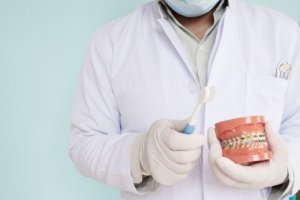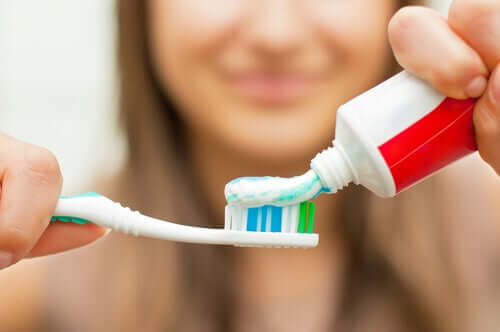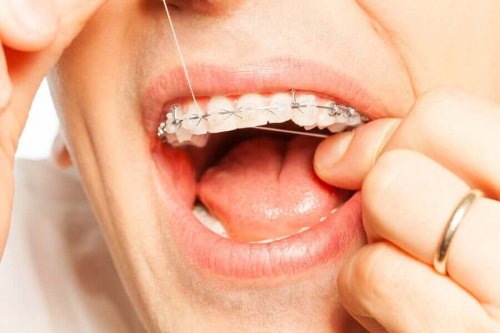Seven Keys to Dental Hygiene with Orthodontics

It isn’t easy to have good dental hygiene with orthodontics. However, at the same time, keeping your teeth and braces clean is essential both to ensure successful treatment and the prevention of problems such as tooth decay and gingivitis.
A person with braces or other orthodontics will have to put a lot of effort into their oral hygiene, especially if they’re fixed. They’ll need to devote more time to it and use all the tools at their disposal to achieve adequate dental hygiene.
Fortunately, the keys to adequate dental hygiene with orthodontics are pretty simple. They’re easy actions that, while they demand more time than usual, also guarantee that you won’t suffer from additional problems in the future. Below, we’ll share the seven keys.
1. Tooth brushing habits
The most important measure for proper dental hygiene with orthodontics is tooth brushing. You should brush your teeth at least three times a day. However, it’s advisable to also brush your teeth after eating anything or drinking any sugary drink.

Tooth brushing is one of the most important oral hygiene habits. If you have braces, it’s best to brush after eating anything to ensure proper cleaning.
2. The toothbrush
There are special toothbrushes for dental hygiene with orthodontics. They’re V-shaped, which allows them to clean around the orthodontics.
However, many experts believe that it’s best to use an electric toothbrush. The best electric toothbrushes are rechargeable and have oscillating technology. Plus, you must choose a specific head for orthodontics. It’s even better if the toothbrush has a pressure sensor. This will prevent you from applying excessive pressure and damaging your orthodontics.
This article may interest you: Tooth Decay: What Causes Dental Cavities?
3. Toothpaste
As a rule, it’s best to use fluoride toothpaste, as it helps to increase your resistance to tooth decay and is gentle. Abrasive toothpaste isn’t recommended, as it tends to damage tooth enamel and sometimes affect braces.
If you have another problem, such as halitosis or gingivitis, consult your dentist, as they’ll recommend the type of toothpaste you should use. However, remember that toothpaste is only a compliment. Brushing is the most important thing.
4. Flossing
Yes, you must floss. Flossing allows you to reach interdental spaces to achieve proper dental hygiene with orthodontics. However, when you have braces, no matter how exhaustively you brush your teeth, you’ll always miss some spots.
Braces expose you more to leaving small food scraps in the teeth without you even noticing them. Ideally, you should use waxed dental floss; it’s better if it has a floss threader. You must move the floss gently up and down. Then, floss the interdental spaces.

Flossing helps remove food waste between the teeth and braces.
5. The importance of plaque revealer
Plaque revealer helps identify areas where there’s minimal food waste. You can’t rely on brushing, even more so if you use fixed orthodontics, because you can overlook some areas and there are many very hard-to-reach spots.
You should use it after brushing. Not only does it tell you the areas you should brush again, but it also helps you know the points where you’re not achieving proper dental hygiene.
You should definitely read this article: Dental Abscesses and How to Treat Them
6. Mouthwash
Mouthwash is essential for those who have braces. It’s used after brushing. Its main function is to remove bacteria and other microorganisms.
Some mouthwashes are especially suitable for those who have orthodontics, as they have components that don’t damage these devices. In any case, a good mouthwash with fluoride helps protect tooth enamel.

Using mouthwash is a good complement for dental hygiene. In addition, it helps eliminate bacteria.
7. Oral irrigator
An oral irrigator is a perfect complement for maintaining good dental hygiene. However, don’t forget that, especially when you have braces, there are several areas where small food scraps can build up and go unnoticed.
An oral irrigator provides a stream of pulsating water that reaches all corners of the mouth. It’s fully suitable for those who require special care in their dental hygiene. There are several types of oral irrigators on the market, ranging from simple ones to those with sophisticated features.
Conclusion
It’s necessary to boost oral hygiene habits if you have braces. Therefore, it’s recommended to improve brushing, choose suitable toothbrushes, and use other items such as dental floss and mouthwash. It’s also essential to go to the orthodontist regularly.
All cited sources were thoroughly reviewed by our team to ensure their quality, reliability, currency, and validity. The bibliography of this article was considered reliable and of academic or scientific accuracy.
- Soria-Hernández, M. A., Molina, N., & Rodríguez, R. (2008). Hábitos de higiene bucal y su influencia sobre la frecuencia de caries dental. Acta pediátrica de México, 29(1), 21-24.
- Arnold WH, Dorow A, Langenhorst S, Gintner Z, Bánóczy J, Gaengler P. Effect of fluoride toothpastes on enamel demineralization. BMC Oral Health. 2006;6:8. Published 2006 Jun 15. doi:10.1186/1472-6831-6-8
- Asl Aminabadi N, Balaei E, Pouralibaba F. The Effect of 0.2% Sodium Fluoride Mouthwash in Prevention of Dental Caries According to the DMFT Index. J Dent Res Dent Clin Dent Prospects. 2007;1(2):71–76. doi:10.5681/joddd.2007.012
- Cozzani M, Ragazzini G, Delucchi A, et al. Oral hygiene compliance in orthodontic patients: a randomized controlled study on the effects of a post-treatment communication. Prog Orthod. 2016;17(1):41. doi:10.1186/s40510-016-0154-9
- Atassi, F., & Awartani, F. (2010). Oral hygiene status among orthodontic patients. Journal of Contemporary Dental Practice, 11(4), 25–32.
This text is provided for informational purposes only and does not replace consultation with a professional. If in doubt, consult your specialist.








